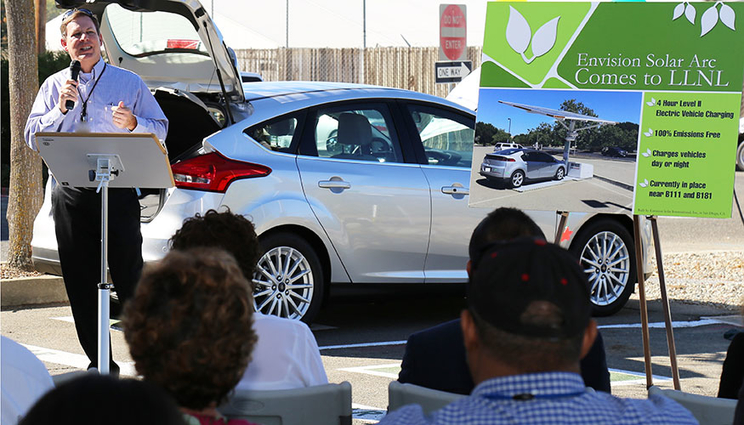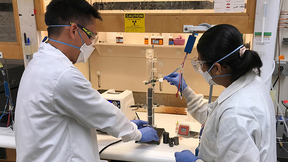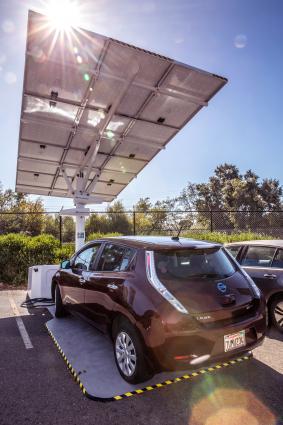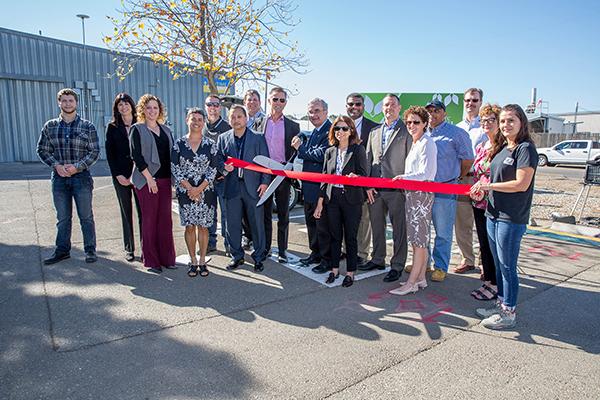Laboratory pilots electric vehicle program
 (Download Image)
Stu Jossey, division leader for LLNL's supply and distribution division leader, left, announced a recently launched government-owned electric vehicle program, helping Lawrence Livermore and its employees to be proactive in reducing emissions and to meet future sustainability goals. Photos by George Kitrinos/LLNL
(Download Image)
Stu Jossey, division leader for LLNL's supply and distribution division leader, left, announced a recently launched government-owned electric vehicle program, helping Lawrence Livermore and its employees to be proactive in reducing emissions and to meet future sustainability goals. Photos by George Kitrinos/LLNL
Through a collaboration with the Department of Energy (DOE), Lawrence Livermore National Laboratory (LLNL) recently launched a government-owned electric vehicle program, helping the Lab and its employees to be proactive in reducing emissions and meeting future sustainability goals. See the video.
The program is threefold. The Lab added a Level II charging station and two Level II solar-powered charging units to service a newly deployed fleet of 10 government-owned electric vehicles provided by DOE, also enhancing the Lab’s current personal electric vehicle program that benefits many LLNL commuters.
LLNL established a successful personal plug-in electric vehicle (PEV) charging program in 2014 to accommodate the increasing number of employees driving PEVs to work. Although the program charges employees for the use of electricity, it offers convenience for those who choose to participate and has been extremely popular.
The Lab’s Environment, Safety and Health Sustainability Analyst Heather Ottaway assisted the Operations and Business Directorate with implementing the personal PEV charging program. "The personal PEV program is filling a need for employees, but also helps the Laboratory to reduce its impact to the environment," Ottaway said. "I am excited to see how the program has parlayed into something bigger. My hope is that it continues to grow and serves as a model for other national laboratories."
This program came to be through many discussions between DOE and the Laboratory’s Fleet Management Program. DOE recognized LLNL’s successful personal electric vehicle charging program and determined LLNL would be a perfect site to pilot a program and introduce a fleet of 10 government-owned electric vehicles, replacing 10 gas-powered vehicles.
In preparation for the new fleet, the Laboratory needed a sustainable electric vehicle charging infrastructure. Contracting with ChargePoint, the Lab built a Level II charging station. The new station, which was completed Oct. 1, can charge electric vehicles in half the time as a standard Level I charging station. To supplement this effort, the Laboratory also acquired two portable Level II solar-powered charging units from Envision Solar that were deployed on site in mid-October, providing a clean, green, impact-free charging system for government and employee personal vehicles.
A ribbon-cutting ceremony, introducing the electric and solar charging stations and fleet of 10 government-owned electric Ford Focus vehicles, was recently held on site. Lab managers, DOE Headquarters Fleet Manager Dante Tan, vendors and local community leaders attended the ceremony, hosted by the Laboratory’s Fleet Management/Asset Management Department within the Operations and Business Directorate.
"In the movie 'Field of Dreams,' the key phrase is 'If you build it, he will come,' " said Stu Jossey, Supply and Distribution division leader at LLNL. "Well, the story of this Laboratory’s recent government-owned electric vehicle journey can be summarized as "If you build it (the charging infrastructure), they will come -- 10 fully electric government-owned sedans, and a lot more charging potential for our employees who drive electric vehicles."
"It took a village to make this happen, from summer students, who took the initiative to do the initial research in charging options, to Lab workers and managers, along with our DOE and NNSA colleagues," said Tom Gioconda, deputy director of LLNL.
Use of the new government electric vehicles in place of gas-powered vehicles will reduce LLNL’s annual greenhouse gas emissions by over three metric tons of carbon dioxide equivalent (MTCO2e - about 0.3 MTCO2e per car). Employees who switch to driving a fully electric vehicle can expect to reduce their individual annual carbon footprint by about three MTCO2e (based on an average roundtrip commute of 45 miles).
"We are excited about this opportunity to convert a portion of our fleet of government-owned vehicles to electric," said Hanif Nassor-Covington, fleet manager at LLNL. "Our employees are very eager to take advantage of the solar charging opportunity at locations across our facility."
Allowing employees to charge their vehicles on site and by replacing 10 gas-powered vehicles with government-owned electric vehicles makes a positive impact on the environment.
Tan acknowledged that DOE will provide the Laboratory with an additional 10 vehicles per year with its commitment to build more Level II chargers.
Christine Rodriguez, assistant to the city manager, represented the city of Livermore at the event. "On behalf of the city, we are excited to acknowledge the Laboratory for its continued commitment to a green infrastructure and sustainable business practices," she said.
The Laboratory has inspired other national labs to follow suit. Lawrence Berkeley National Laboratory, Sandia National Laboratories and others are in the planning phase to follow in LLNL’s footsteps. In the future, the Laboratory hopes to transition 30 percent of its fleet to zero-emissions vehicles.
"The Laboratory now has the electric vehicle program in our sustainability plan," Nassor-Covington said. "We are really in the forefront -- we are ahead of the curve. The more electric vehicles that we have means less green gas emissions emitting into the atmosphere. It’s about saving the planet and the environment."
Contact
 Carrie L Martin
Carrie L Martin
[email protected]
(925) 424-4715
Related Links
Department of EnergyVideo
Tags
EnergyEnvironment Safety and Health
Featured Articles









